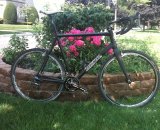Ryan Trebon and Barry Wick have a new weapon in their race kits. While shooting the latest and greatest at the Crankworx festival in Whistler, Cyclocross Magazine contributor Joe Sales was able to catch a glimpse of the new all-carbon Kona Major Jake. The new photos provide a closer look at the updated ride that we profiled earlier this summer.
by Jamie Mack
In the world of ’cross bikes, 17 pounds is a respectable weight that many manufacturers claim for their average size frames. With a new ’cross frame revealed during the Sea Otter festival earlier this year, Kona has met that benchmark with the bikes built for two of the tallest riders in ’cross, Ryan Trebon and Barry Wicks. Typically found on custom 62+cm frames, the Twin Towers of Kona ride some of the biggest, and perhaps heaviest, frames in the Elite field. But their new 2011 Kona Jakes are taking things to a lower level, in weight anyway, and giving the Kona duo a leg up on the competition. Cyclocross Magazine was able to check in with Barry Wicks and get the inside story on the new rides.
Kona was given a simple mission by their star riders – make a bike that was lighter, stiffer and faster than one of the most respected frames on the circuit. And don’t dare sacrifice the ride quality and durability that the scandium Major Jakes have shown over the past few years. And do it all in a 63cm frame. Nothing like a little pressure from the daunting pair of Elite ’cross riders to bring sweat to the brow of a few engineers and builders.
According to Wicks, there was no problem. “I don’t know how they did it, but they were able to produce a bike for us that met all our specific targets.” Wicks tried to clarify the expectations the riders had passed to the development team, saying, “from the perspective of a racer, we are always trying to make our bikes lighter, stiffer and faster. The scandium Major Jake frames that we have been riding for the last few seasons have been awesome, but we wanted to see if we could push it a little bit further.”
Kona pushed things more than a little bit. For this year’s team bikes, Kona dove straight in and came up with the all-carbon Kona Jake. But the development team didn’t stop with a simple change of materials, they used the flexibility of the design aspects and construction characteristics unique to carbon to incorporate other features that ’cross racers would appreciate.
Stiffness was a chief concern expressed by Wicks and Trebon in working with the development team on the new frame. Wicks confirmed this, saying, “The biggest worry Ryan and I had when moving to a carbon frame was maintaining stiffness. We are both pretty big guys who put out a lot of power, so just enlarging some off-the-shelf carbon frame was not an option.” Key areas of the frame, such as the bottom bracket junction, show the attention that was paid to maintaining the stiffness needed for the frame to be raced at the highest level. Recent photos show that the front end incorporates additional material at the seat tube/head tube junction to increase stiffness.
The incorporation of a BB30 bottom bracket shell was a fairly simple step, but again Kona went further. The hexagonal down tube is almost as wide as the bottom bracket shell, providing a stable platform for putting power to the pedals. Chainstays are box-section pieces that emerge from a joint, again nearly as wide as the bottom bracket shell. Looking at the junction of all this carbon, the stiffness is evident, but so is the ’cross-specific design. The chainstays flare out at the wheel to allow for generous mud clearance. The seatstays are a similarly stout affair, with the wishbone design beginning with a stout tube emerging from the seat junction and flaring at the wheel to allow for mud clearing.
The other tubes of the frame also show the effective use of carbon with a nod to the off-road destiny of the Jake. The tapered head tube allows for greater stiffness in the hectic starts of a ’cross race while also aiding steering and helping to eliminate brake chatter. The flattened top tube makes it a little more comfortable to portage through the run sections common on cyclocross courses. Internal cable routing is used for the derailleur and rear brake cables to help ensure that the conditions this bike is likely to see won’t slow it down.
The one area that Kona was content to leave intact from previous models was the geometry. This allows the geometry that has been refined by nearly 10 years of Elite rider input to remain, meaning that riders used to the handling of previous models will feel right at home on the new carbon frame. Wicks was particularly happy with this aspect of the development, saying, “The ride is awesome. We stuck with the same tried and true Kona ’cross geometries that we have been refining, so the bike is very familiar to us and handles well.”
Development of a carbon frame for cyclocross is a balance of maintaining stiffness while taking advantage of carbon’s ability to dampen small vibrations. The vibration dampening is often overlooked in ’cross because of the overly rough terrain, but most of us will take any little piece of comfort we can get during the 45 to 60 minutes of pain and torture of a race.
The prototype that Wicks has spent a good deal of time on this spring and summer isn’t built up with the snazzy, race-only specs that he enjoys during the year. He’s been using a mix of more durable, if heavier, components and clincher wheels. And that’s the bike that comes in at that magic number of 17 pounds. Wicks is happy with the weight of the bike and for the upcoming season expects that “once I have full race spec on the bike, it will be close to 16lbs.” That’s pretty light on anyone’s scale, and it’s even more impressive for a 63cm bike.
While some details remain unconfirmed, including finishes and build specs, it seems that both Wicks and Trebon are aching to be racing aboard the new rides this fall. Wicks summed up his feelings about the new team bikes in the way only he can, saying, “Essentially, we took the already awesome Scandium Major Jake, sprinkled a little magic fairy dust on top and came out with a bike that is 30% more awesome.”
Photo Galleries










































